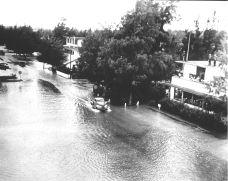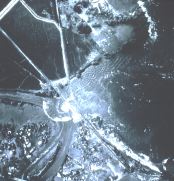1952 Kamchatka Peninsula Tsunami
On November 4, 1952, at 16:52 GMT, an earthquake occurred off the coast of the Kamchatka Peninsula, Russia. A Pacific-wide tsunami was triggered by the earthquake, which had a surface-wave magnitude of 8.2, an epicenter of 52.8° N, 159.5° E, and a focal depth of 30 km. Six cows died and no human lives were lost in Hawaii where damage estimates ranged from $800,000- $1,000,000 (1952 dollars).

 Flooded street resulting from the arrival of the Kamchatka tsunami on Midway Island about 3,000 km away from the origin. Photograph Credit: U.S. Navy. Source: National Geophysical Data Center.
Flooded street resulting from the arrival of the Kamchatka tsunami on Midway Island about 3,000 km away from the origin. Photograph Credit: U.S. Navy. Source: National Geophysical Data Center.
The tsunami had caused severe damage to Kamchatka Peninsula and then proceeded throughout the pacific. Midway Island was innundated with 1 m of water, flooding streets and buildings. On the Hawaiian Islands the waves destroyed boats, knocked down telephone lines, destroyed piers, scoured beaches, and flooded lawns. In Honolulu Harbor a cement barge was thrown into a freighter. In Hilo Bay a small bridge connecting Cocoanut Island to the shore was destroyed by a wave when it lifted off its foundation and then smashed down.


Aerial view of Kaika Bay near Haleiwa on the north shore of Oahu shows the fourth wave climbing up beach toward the beach houses and shows the extent of inundation from previous waves. Photograph Credit: George Curtis. Source: National Geophysical Data Center.
At Cocoanut Island the water swept in with a run-up of 12 feet. It was observed in Hilo that the run-up could have been as high as 11 1/2 feet. Also in Hilo, at Reed's Bay, the water level rose as high as 11 feet. Hilo Bay recorded the highest levels of run-up. At most of the other coastal cities in Hawaii, the water rise was barely noticeable. During this event, the interesting observation was made that the highest or most destructive wave would vary from location to location. Without knowing which wave will be the largest at a particular location the local authorities must properly warn residents that could be affected and keep them away from the shore until it is safe to return.
References




 Flooded street resulting from the arrival of the Kamchatka tsunami on Midway Island about 3,000 km away from the origin. Photograph Credit: U.S. Navy. Source: National Geophysical Data Center.
Flooded street resulting from the arrival of the Kamchatka tsunami on Midway Island about 3,000 km away from the origin. Photograph Credit: U.S. Navy. Source: National Geophysical Data Center. 



